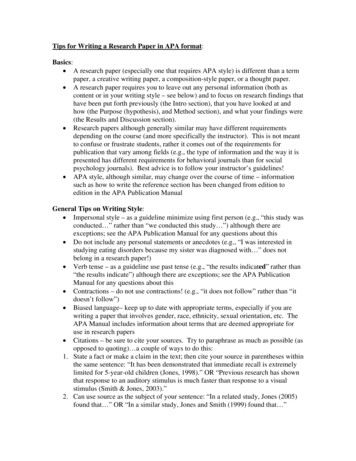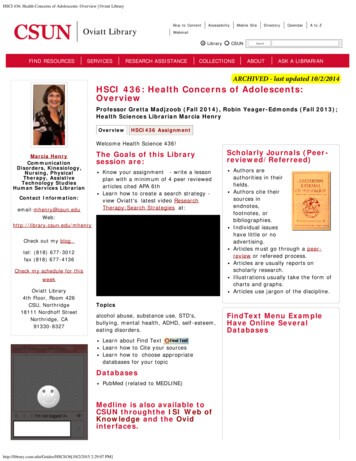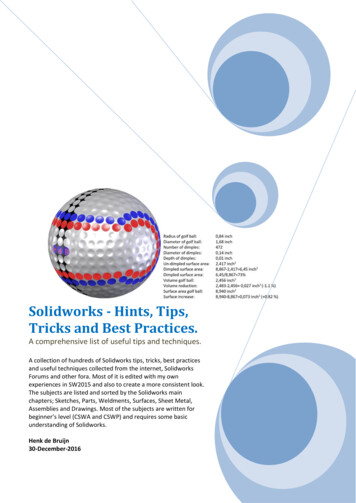
Transcription
Tips for Writing a Research Paper in APA format:Basics: A research paper (especially one that requires APA style) is different than a termpaper, a creative writing paper, a composition-style paper, or a thought paper. A research paper requires you to leave out any personal information (both ascontent or in your writing style – see below) and to focus on research findings thathave been put forth previously (the Intro section), that you have looked at andhow (the Purpose (hypothesis), and Method section), and what your findings were(the Results and Discussion section). Research papers although generally similar may have different requirementsdepending on the course (and more specifically the instructor). This is not meantto confuse or frustrate students, rather it comes out of the requirements forpublication that vary among fields (e.g., the type of information and the way it ispresented has different requirements for behavioral journals than for socialpsychology journals). Best advice is to follow your instructor’s guidelines! APA style, although similar, may change over the course of time – informationsuch as how to write the reference section has been changed from edition toedition in the APA Publication ManualGeneral Tips on Writing Style: Impersonal style – as a guideline minimize using first person (e.g., “this study wasconducted ” rather than “we conducted this study ”) although there areexceptions; see the APA Publication Manual for any questions about this Do not include any personal statements or anecdotes (e.g., “I was interested instudying eating disorders because my sister was diagnosed with ” does notbelong in a research paper!) Verb tense – as a guideline use past tense (e.g., “the results indicated” rather than“the results indicate”) although there are exceptions; see the APA PublicationManual for any questions about this Contractions – do not use contractions! (e.g., “it does not follow” rather than “itdoesn’t follow”) Biased language– keep up to date with appropriate terms, especially if you arewriting a paper that involves gender, race, ethnicity, sexual orientation, etc. TheAPA Manual includes information about terms that are deemed appropriate foruse in research papers Citations – be sure to cite your sources. Try to paraphrase as much as possible (asopposed to quoting) a couple of ways to do this:1. State a fact or make a claim in the text; then cite your source in parentheses withinthe same sentence: “It has been demonstrated that immediate recall is extremelylimited for 5-year-old children (Jones, 1998).” OR “Previous research has shownthat response to an auditory stimulus is much faster than response to a visualstimulus (Smith & Jones, 2003).”2. Can use source as the subject of your sentence: “In a related study, Jones (2005)found that ” OR “In a similar study, Jones and Smith (1999) found that ”
Sections of an APA formatted research paper:Title Page Should include a running head (an abbreviated title, no more than 50characters long and is in all capital letters) and page number, title, authorname(s), and affiliation – all double-spaced (should not include instructor’sname, name of the course, etc.) Title – centered about half-way down pageo Ex: “Correctly Using APA Format in a Research Paper” Name – centered under titledo Ex: “Jane Smith” Affiliation – school you are attending; centered under name(s)o Ex: “University of North Dakota”The running head is anabbreviated version ofyour title, normally thefirst 4 or 5 words ofyour title (Note: theuse of “Running head:”is for research papersonly, not for lit reviews,experimental papers,or meta‐analyses)The title of thepaper, name of theauthor, andaffiliation should becentered bothvertically andhorizontally on thepage, and doublespacedPage numbersare always inthe upper righthand corner
Abstract Should include a basic description of the study in about one sentence persection of an APA paper Should be between 150 - 250 Should look like:“Running head:” isnow removed for allremaining sectionsCentered and notboldPage numbersare always inthe upper righthand cornerThe abstract shouldbe the 2nd page ofyour paper, andshould be the onlything on that page.Listing keywords help researchers find your article in databases.
Introduction – Should include: Clear and explicit introduction of the construct being investigated All constructs should be accurately and clearly defined Literature review conveys what is known about the construct under investigation Literature used in review is appropriate (i.e., from a professional journal) Literature used in review is accurate in ideas Logical presentation of ideas (i.e., no illogical jumps or omissions) Research proposed is discussed in the context of what is already known Hypotheses are stated Should look like:Title of your paper iscentered and notboldPage numbersare always inthe upper righthand cornerSub‐headings arebold and leftjustifiedPage numbersare always inthe upper righthandcornerListing keywords help researchers find your article indatabases.In‐text citation:Bandura, Ross, andRoss (1963)Another example ofan in‐text citation:(Bandura, 1978)Listing keywords help researchers find your article in databases.
MethodShould provide sufficient information to allow reader to easily replicate study, including: Participantso Describe how many (N ), gender, race/ethnicity, mean age, etc. (anydemographic information that may be relevant to the study) as well as howparticipants were recruited Materialso Describe measures or apparatus used, include information about the scaleof any measures as well as validity and reliability if available Procedureo Describe the process of conducting the study (e.g., signing of informedconsent, the order of procedures – or questionnaires, if or how participantswere compensated for their time, any debriefing procedure, etc.) Should look like:Method startswherever theintroduction endsPage numbersare always inthe upperrightBoldand centeredhand cornerDescribe participantsDescribe materials used(questionnaires,vignettes, ect.)Explain the process ofthe studyListing keywords help researchers find your article in databases.
Results - Should include: Appropriate statisticso This will depend on the design of your study; see your instructor withquestions pertaining to the appropriate statistical test to useo The exact value is reported, for instance p .02, NOT p .05 Appropriate presentation of statisticso An example of appropriate presentation for an ANOVA is given below;consult the APA Manual (or your instructor) regarding appropriatepresentation for differing statistics (i.e., how to present a t-test vs. anANOVA) Appropriate interpretation of statisticso Be sure you are interpreting the meaning of your results accurately (e.g.,p .04 significant result); know what the numbers mean Should look like:Results start immediatelyafter methodsPage numbersare alwaysBoldinand centeredthe upper righthand cornerState the test usedListing keywords help researchers find your article in databases.Report the properstatistics andsignificance
Discussion – Should include: A clear statement of support or nonsupport of the original hypotheses An exploration of the similarities and differences between the present findingsand the work of others, including relating findings to applicable theory A description of limitations and alternative explanations Commentary on the importance and implications of the findings Should look like:Bold and centeredRestate hypothesisRestate resultsRelate findings toprevious researchDiscuss implicationsof your studyDiscuss limitationsof your study andpotential futureresearchPage numbersare always inthe upper righthand corner
References Should be in alphabetical order, see examples of different forms of referencesbelowo The examples are of journal articleso Consult the APA Manual for other forms of referencing (e.g., internetsources, edited books) Should look like:Starts on a newpageAlphabetical orderPage numbersare always inthe upper righthand corner
Tables/Graphs All tables and graphs should be labeled with a number, have a title, listed on itsown page, and included in the appendiceso The example table below is a typical “APA-style” tableo Graphs should be appropriate to the scale being used (e.g., nominal,ordinal, interval, ratio)o Consult the APA Manual or your instructor for further information onother types of tables and graphsTable numberTable titleFigure numberand caption
writing a paper that involves gender, race, ethnicity, sexual orientation, etc. The APA Manual includes information about terms that are deemed appropriate for use in research papers Citations – be sure to cite your sources. Try to paraphrase as much as possibl











